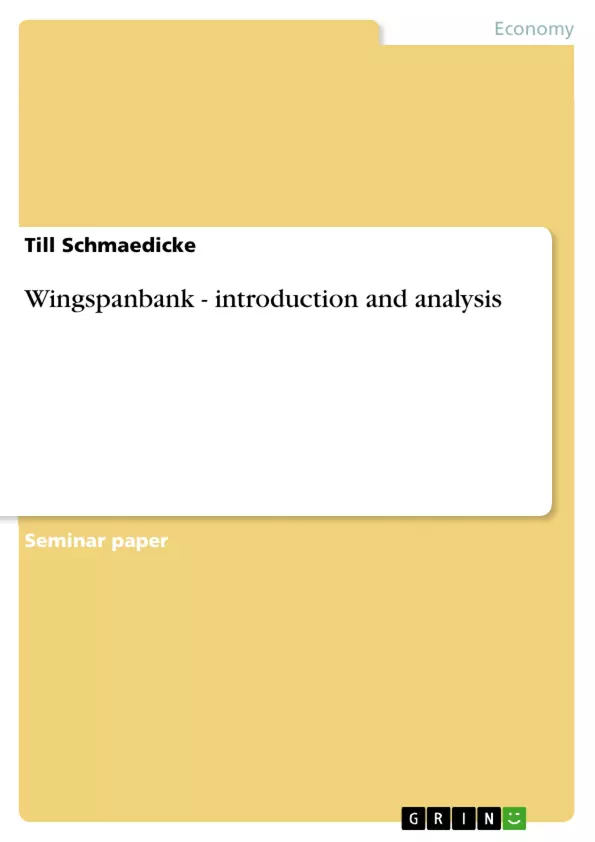Bank One Corporation the number four among the nation’s largest banking and financial institutes made a fundamental shift in its strategy by introducing a Internet-only bank as a separate division of Bank One Corporation in June 1999. Richard Vague, formerly the CEO of the credit card conglomerate First USA, and James Stewart set up the new and additional Internet division of Bank One which was named WingspanBank.com.
The objective of WingspanBank.com was to offer convenient, comprehensive, and objective solutions to customers at competitive prices. The national scope was to extend Wingspanbank.com beyond the 14 states in which Bank One already operated. Additionally WingspanBank.com targeted on a segment Bank One could not reach with its branches – the growing group of Internet users who disdained traditional banks. Both, the present and future users of Internet banking should have given WingspanBank.com as well as its parent company Bank One Corporation a competitive advantage over its main rivals such as Bank of America, Citigroup, US Bankcorp., NetB@nk, chase.com and wellsfargo.com.
The one million new accounts for WingspanBank.com expected by management were a very unrealistic objective. WingspanBank.com’s strategy and an alliance with Lycos continued to focus on Internet users only and not on establishing any branch system even though surveys indicated the desire of customers to have branches and a physical contact to banks as well. Unfortunately WingspanBank.com was reintegrated into the Bank One Corporation holding structure by June, 2001. This resulted also out of problems with First USA, a bad press about Bank One and the resignations of several Wingspanbank.com executives.
Table of Contents
- Executive Summary
- Bank One Corporation
- Bank One's History
- Corporate Profile
- Internet Banking
- The Development of Internet Banking
- The Growth of Internet Banking
- Internet Banking as a Strategic Necessity
- Driving Factors of Internet Banking
- The Opportunity for Internet Banking
- The Biggest Obstacle to Success
- WingspanBank.com
- WingspanBank's Introduction
- WingspanBank.com's Implementation in Bank One Corporation
- WingspanBank.com's Features
- WingspanBank's Alliance with Lycos
Objectives and Key Themes
This case study examines the launch and subsequent failure of WingspanBank.com, a subsidiary of Bank One Corporation, which aimed to provide online banking services to a wider customer base than traditional banking branches could reach. The case explores the strategic rationale behind Bank One's decision to create WingspanBank.com, the challenges faced by the online bank, and the eventual reasons for its integration back into Bank One Corporation.
- The emergence of internet banking as a strategic necessity for traditional banks
- The challenges of establishing a successful online banking platform
- The impact of strategic alliances on the success of online banking initiatives
- The role of customer preferences and market dynamics in online banking
- The importance of internal organizational structure and alignment in supporting strategic initiatives
Chapter Summaries
The Executive Summary provides an overview of Bank One Corporation's strategic shift towards internet banking with the launch of WingspanBank.com. The goal was to expand the customer base and reach a growing segment of internet users. Chapter 2 delves into the history and corporate profile of Bank One Corporation, highlighting its size and significant position within the banking sector. Chapter 3 explores the development, growth, and necessity of internet banking, examining the driving factors behind its rise and the opportunities it presents. Chapter 4 introduces WingspanBank.com, its implementation within Bank One Corporation, its features, and its strategic alliance with Lycos. The chapter also discusses the reasons for the online bank's eventual failure and integration back into Bank One Corporation.
Keywords
This case study focuses on key topics such as strategic management, online banking, market dynamics, organizational structure, customer preferences, strategic alliances, and the challenges of launching and sustaining a successful online banking platform. It examines the implementation of WingspanBank.com as a strategic initiative and the factors that contributed to its eventual failure.
- Citar trabajo
- Till Schmaedicke (Autor), 2002, Wingspanbank - introduction and analysis, Múnich, GRIN Verlag, https://www.grin.com/document/29649



